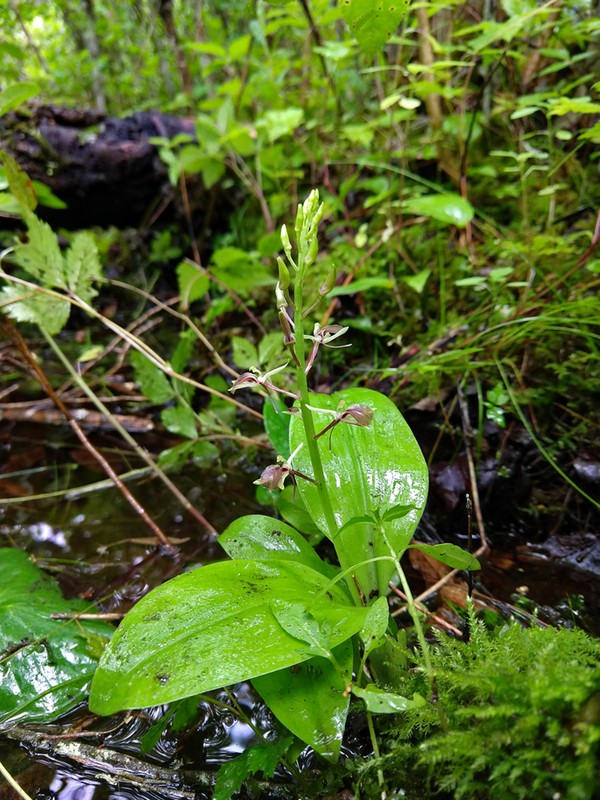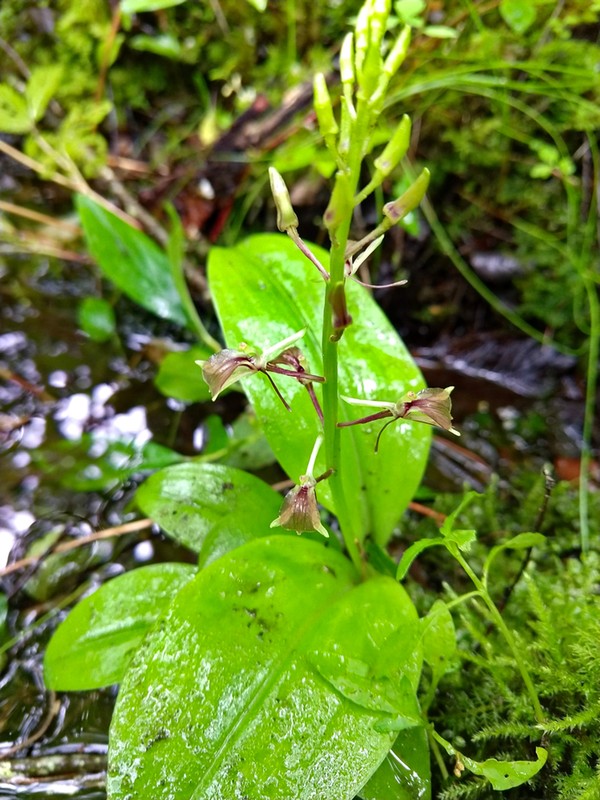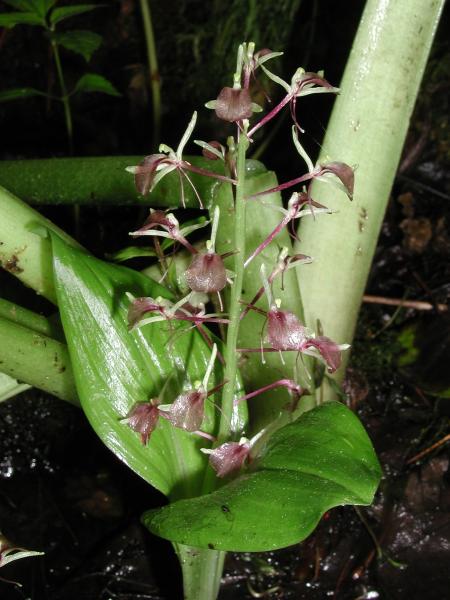Lily-leaved Twayblade
Liparis liliifolia (L.) L.C. Rich. ex Ker-Gawl.
- Class
- Monocotyledoneae (Monocots)
- Family
- Orchidaceae (Orchid Family)
- State Protection
- Endangered
Listed as Endangered by New York State: in imminent danger of extirpation in New York. For animals, taking, importation, transportation, or possession is prohibited, except under license or permit. For plants, removal or damage without the consent of the landowner is prohibited.
- Federal Protection
- Not Listed
- State Conservation Status Rank
- S1
Critically Imperiled in New York - Especially vulnerable to disappearing from New York due to extreme rarity or other factors; typically 5 or fewer populations or locations in New York, very few individuals, very restricted range, very few remaining acres (or miles of stream), and/or very steep declines.
- Global Conservation Status Rank
- G5
Secure globally - Common in the world; widespread and abundant (but may be rare in some parts of its range).
Summary
Did you know?
Over the decades there have been many arguments as to whether this species name is spelled with one i or a double i. It has been shown that the correct spelling should be with a double i. The flowers are pollinated by flies and the seeds can germinate and grow only in association with a specific mycorrhizal fungi that is the same throughout its range (Mattrick 2004).
State Ranking Justification
There are eight existing populations but only one has more than 100 plants. All other occurrences contain five or fewer plants. There are 52 historical records but most of them do not contain specific enough location information to relocate the plants that occur only in small numbers. Many of the occurrences from the Lower Hudson region could be extirpated.
Short-term Trends
Four of the existing eight populations have been resurveyed and the plants still existed in three of them. It seems that populations tend to remain at low numbers for many years. All populations should be checked to better understand short-term trends.
Long-term Trends
There are 52 historical records but now only eight existing populations so it seems that there has been a substantial decline over the last 100 years. Many historical records are from highly developed areas with high deer populations even though substantial natural areas exist where small populations of orchids could remain. The small number of plants in a population could make them difficult to relocate and they may be more common than we think. The maturation of early to mid-successional forests where this species thrived has reduced populations from the late 1800s and early 1900s when these habitats were dominant.
Conservation and Management
Threats
Potential threats to existing orchid populations are flooding by beaver activities or the draining of their swamp habitat. Spraying insecticides to control mosquitos may inadvertently kill the flies that pollinate this orchid. Populations are also threatened by forest maturation from the early to mid-successional stages that this orchid prefers. Inbreeding depression may also reduce populations (Mattrick 2004).
Conservation Strategies and Management Practices
Establish sufficient buffers around populations to preserve the hydrology of their habitat. Experiment with different forest management techniques to observe whether different successional stages increase populations.
Research Needs
Research is needed to determine why almost all populations contain only a few plants while one population contains over 100. It should also be studied whether deer significantly affect this species and whether populations can be increased by forest management.
Habitat
Habitat
In New York Large Twayblade is known to occur in a variety of both upland and wetland habitats. It has been found in several red maple-dominated swamps with a substrate of sphagnous peat, growing on hummocks. In contrast it also occurs in dry woods on limestone-influenced soil and wooded talus slopes, and along RR grades at the edge of swamps (New York Natural Heritage Program 2007). Loamy or sandy woods and clearings (Fernald 1970). Rich woods (Gleason 1952). Rich woods (Gleason & Cronquist 1991). Brushy second-growth thickets and mixed woods, floodplains, pine plantations (Voss 1985). Often growing on seldom used paths or old logging roads through mixed woodland (T. Weldy pers. comm.). It seems Liparis liliifolia is an early to mid-successional forest species that prefers areas that are recovering from disturbance. It appears to prefer a small window of succession after aggressive weeds have declined and before the canopy provides too much shade (Mattrick 2004).
Associated Ecological Communities
- Limestone woodland
(guide)
A woodland that occurs on shallow soils over limestone bedrock in non-alvar settings, and usually includes numerous rock outcrops. There are usually several codominant trees, although one species may become dominant in any one stand.
- Red cedar rocky summit*
(guide)
A community that occurs on warm, dry, rocky ridgetops and summits where the bedrock is calcareous (such as limestone or dolomite, but also marble, amphibolite, and calcsilicate rock), and the soils are more or less calcareous. The vegetation may be sparse or patchy, with numerous lichen covered rock outcrops.
- Red maple-hardwood swamp
(guide)
A hardwood swamp that occurs in poorly drained depressions, usually on inorganic soils. Red maple is usually the most abundant canopy tree, but it can also be codominant with white, green, or black ash; white or slippery elm; yellow birch; and swamp white oak.
- Shrub swamp
(guide)
An inland wetland dominated by tall shrubs that occurs along the shore of a lake or river, in a wet depression or valley not associated with lakes, or as a transition zone between a marsh, fen, or bog and a swamp or upland community. Shrub swamps are very common and quite variable.
* probable association but not confirmed.
Associated Species
- Acer rubrum
- Alnus incana
- Apios americana (groundnut)
- Athyrium filix-femina
- Betula alleghaniensis (yellow birch)
- Bidens
- Boehmeria cylindrica (false nettle)
- Cardamine pratensis (cuckoo-flower)
- Carex leptalea (bristle-stalked sedge)
- Carex rosea (common upland star sedge)
- Carya
- Chamaelirium luteum (fairy-wand, devil's bit)
- Dryopteris campyloptera (mountain wood fern)
- Dryopteris cristata (crested wood fern)
- Fraxinus nigra (black ash)
- Fraxinus pennsylvanica (green ash)
- Galium obtusum
- Glyceria canadensis (rattlesnake manna grass)
- Ilex glabra (inkberry)
- Impatiens capensis (spotted jewelweed, spotted touch-me-not)
- Juniperus virginiana
- Leersia oryzoides (rice cut grass)
- Lindera benzoin (spicebush)
- Menyanthes trifoliata (buck-bean)
- Osmunda cinnamomea
- Osmunda regalis
- Parthenocissus quinquefolia (Virginia-creeper)
- Persicaria arifolia (halberd-leaved tear-thumb)
- Photinia melanocarpa
- Pinus strobus (white pine)
- Polystichum acrostichoides (Christmas fern)
- Quercus
- Rhododendron viscosum (swamp azalea)
- Rubus pubescens (dwarf raspberry)
- Scutellaria galericulata (marsh skull-cap)
- Sphagnum
- Symplocarpus foetidus (skunk-cabbage)
- Thalictrum dioicum (early meadow-rue)
- Thelypteris palustris
- Toxicodendron radicans
- Toxicodendron vernix (poison-sumac)
- Ulmus rubra (slippery elm)
- Vaccinium corymbosum (highbush blueberry)
- Viburnum
Range
New York State Distribution
Lipais liliifolia is found at scattered locations throughout New York State except in the far north.
Global Distribution
New York is at the northern edge of the range of Large Twayblade, which occurs in the northeastern and Midwestern States, from Vermont to the very northern portions of Georgia, Alabama, and Mississippi, and from southern Ontario, Michigan, and Wisconsin south to Arkansas.
Identification Comments
General Description
Large Twayblade is a perennial orchid species growing up to 25 cm tall from a bulb-like root, with only a single pair of basal leaves and one central flowering stalk. The leaves are smooth, oval, 5-15 cm long, and entire. They are somewhat shiny, with parallel veins, and their bases form a sheath around the stem. The flowers are light green and mauve-purple. The broad, translucent purplish, drooping lateral petals (forming the lip) are 7-10 mm long and about as wide, contracted at the base into a darker purple spur. The fruit are dry capsules, shorter than their 11-18 mm long pedicels (stalks).
Best Life Stage for Proper Identification
Large Twayblade is most easily identified when in flower, though fruiting individuals may also be determined.
Similar Species
Liparis loeselii has smaller leaves and flowers than L. liliifolia. Both the leaves and flowers are yellowish-green. The leaves are folded along the mid-rib, the lip is about half as long as that of L. liliifolia, and the capsules are longer than their pedicels.
Tipularia discolor (Cranefly Orchid) is another woodland orchid with many purplish-green blossoms on a leafless stalk, but it has a single, winter-green leaf, and much narrower and otherwise distinctive flowers.
Best Time to See
Large Twayblade flowers from June through mid-July, and the fruits persist into October.
- Flowering
- Fruiting
The time of year you would expect to find Lily-leaved Twayblade flowering and fruiting in New York.
Lily-leaved Twayblade Images
Taxonomy
Lily-leaved Twayblade
Liparis liliifolia (L.) L.C. Rich. ex Ker-Gawl.
- Kingdom Plantae
- Phylum Anthophyta
- Class Monocotyledoneae
(Monocots)
- Order Orchidales
- Family Orchidaceae (Orchid Family)
- Order Orchidales
- Class Monocotyledoneae
(Monocots)
- Phylum Anthophyta
Additional Common Names
- Large Twayblade
- Purple Twayblade
Synonyms
- Liparis lilifolia (L.) Richard [orthographic varient]
- Liparis liliifolia auct. non
Additional Resources
Best Identification Reference
Flora of North America Editorial Committee. 2002. Flora of North America, North of Mexico. Volume 26. Magnoliophyta: Liliidae: Liliales and Orchidales. Oxford University Press, New York. 723 pp.
Other References
Clemants, Steven and Carol Gracie. 2006. Wildflowers in the Field and Forest. A Field Guide to the Northeastern United States. Oxford University Press, New York, NY. 445 pp.
Fernald, M.L. 1950. Gray's manual of botany. 8th edition. D. Van Nostrand, New York. 1632 pp.
Gleason, Henry A. and A. Cronquist. 1991. Manual of Vascular Plants of Northeastern United States and Adjacent Canada. The New York Botanical Garden, Bronx, New York. 910 pp.
Holmgren, Noel. 1998. The Illustrated Companion to Gleason and Cronquist's Manual. Illustrations of the Vascular Plants of Northeastern United States and Adjacent Canada. The New York Botanical Garden, Bronx, New York.
Mattrick, Christopher. 2004. Liparis liliifolia (L.) L.C. Rich. ex Lindley (Lily-leaved twayblade) Conservation and Research Plan for New England. New England Wildflower Society, Framingham, Massachusetts, USA.
New York Natural Heritage Program. 2010. Biotics database. New York Natural Heritage Program. New York State Department of Environmental Conservation. Albany, NY.
New York Natural Heritage Program. 2024. New York Natural Heritage Program Databases. Albany, NY.
Newcomb, Lawrence. 1977. Newcomb's Wildflower Guide: An Ingenious New Key System for Quick, Positive Field Identification of the Wildflowers, Flowering Shrubs, and Vines of Northeastern and North-Central North America. Little, Brown and Company. Boston.
Rhoads, Ann F. and Timothy A. Block. 2000. The Plants of Pennsylvania, an Illustrated Manual. University of Pennsylvania Press, Philadelphia, PA.
Voss, E.G. 1972. Michigan Flora, Part I. Gymnosperms and Monocots. Cranbrook Institute of Science Bulletin 55 and the University of Michigan Herbarium. Ann Arbor. 488 pp.
Weldy, T. and D. Werier. 2010. New York flora atlas. [S.M. Landry, K.N. Campbell, and L.D. Mabe (original application development), Florida Center for Community Design and Research http://www.fccdr.usf.edu/. University of South Florida http://www.usf.edu/]. New York Flora Association http://newyork.plantatlas.usf.edu/, Albany, New York
Weldy, Troy W. and David Werier. 2005. New York Flora Atlas. [S.M. Landry, K.N. Campbell, and L.D. Mabe (original application development), Florida Center for Community Design and Research. University of South Florida]. New York Flora Association, Albany, NY. Available on the web at (http://newyork.plantatlas.usf.edu/).
Links
About This Guide
Information for this guide was last updated on: February 1, 2023
Please cite this page as:
New York Natural Heritage Program. 2024.
Online Conservation Guide for
Liparis liliifolia.
Available from: https://guides.nynhp.org/large-twayblade/.
Accessed July 26, 2024.



